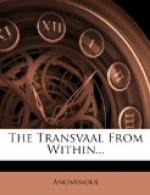[Bivouac, January 1.]
Nothing remained but to bivouac in the best position available.
But for the unfortunate circumstance of the firing, which we afterwards heard was due to the exultation of the Boers at the arrival of large reinforcements from Potchefstroom, the column would have been by this time (7 p.m.) at least four or five miles further on the road to Johannesburg, with an excellent chance of reaching that town without further opposition.
I moved the column to the edge of a wide vley to the right of the road, and formed the horses in quarter-column under cover of the slope. The carts were formed up in rear and on both flanks, and five Maxims were placed along the front so as to sweep the plateau.
The other three Maxims and the heavy guns were posted on the rear and flank faces.
The men were then directed to lie down between the guns and on the side; sentries and cossack posts were posted on each face. Meantime the Boers had occupied the numerous prospecting trenches and cuttings on the plateau at distances from 400 to 800 yards.
[9 p.m.]
At 9 p.m. a heavy fire was opened on the bivouac, and a storm of bullets swept over and around us, apparently directed from all sides except the south-west.
The troops were protected by their position on the slope below the level of the plateau, so that the total loss from this fire, which lasted about twenty minutes, was very inconsiderable.
The men behaved with admirable coolness, and were as cheery as possible, although very tired and hungry and without water.
We were then left unmolested for two or three hours.
[Midnight.]
About midnight another shower of bullets was poured into the camp, but the firing was not kept up for long.
Somewhat later a Maxim gun opened on the bivouac, but failed to get our range.
[Thursday, January 2.]
At 3.30 a.m. patrols were pushed out on all sides, while the force as silently and rapidly as possible was got ready to move off.
At 4 a.m. a heavy fire was opened by the Boers on the column, and the patrols driven in from the north and east sides.
Under the direction of Major R. White (assisted by Lieutenant Jesser-Coope) the column was formed under cover of the slope.
Soon after this the patrols which had been sent out to the south returned, and reported that the ground was clear of the Boers in that direction.
The growing light enabled us to ascertain that the Boers in force were occupying pits to our left and lining the railway embankment for a distance of one and a half miles right across the direct road to Johannesburg.
I covered the movements of the main body with the B.B.P. and two Maxims under Colonel Grey along the original left front of the bivouac, and two troops M.M.P., under Major K. White on the right front.
During all this time the firing was excessively heavy; however the main body was partially sheltered by the slope.




